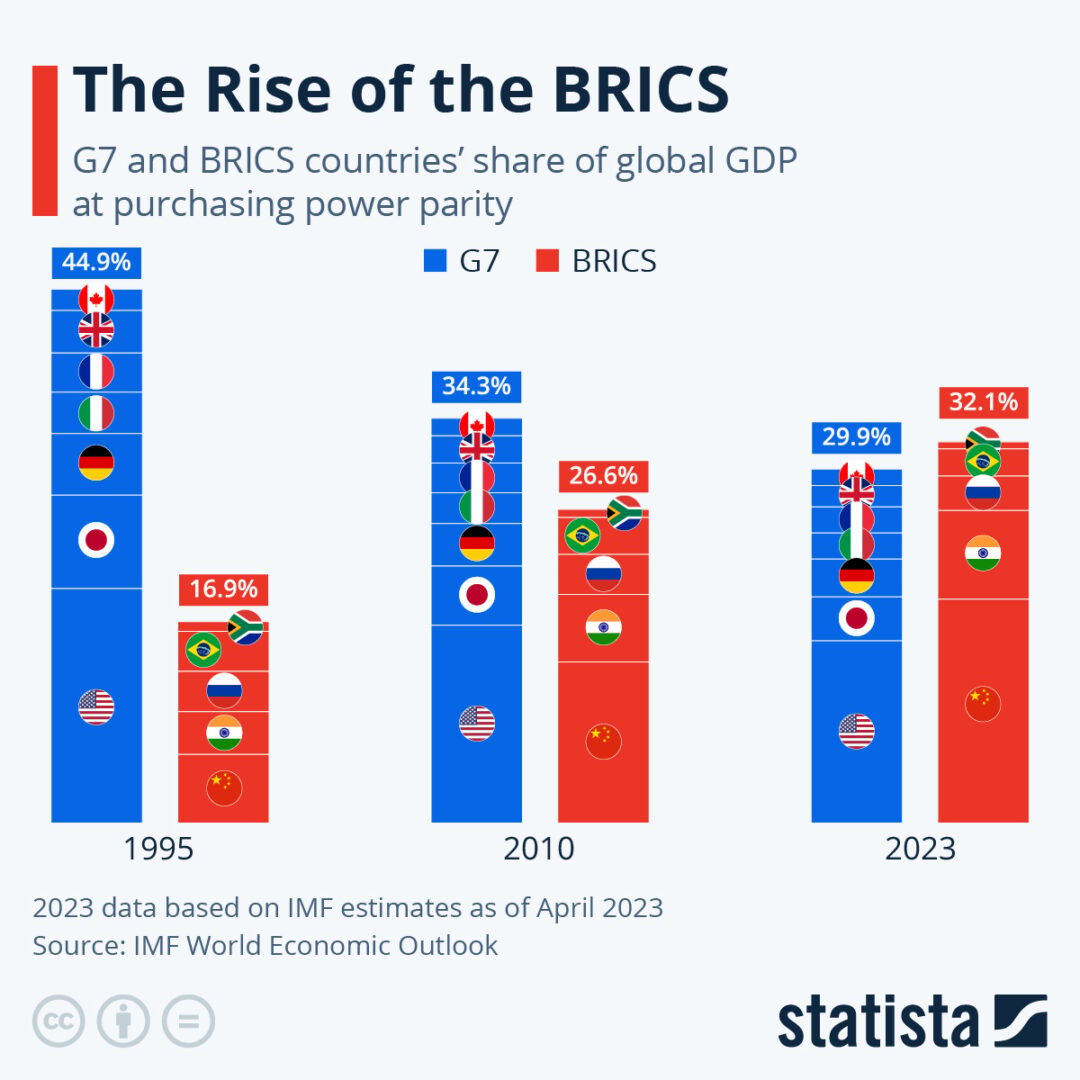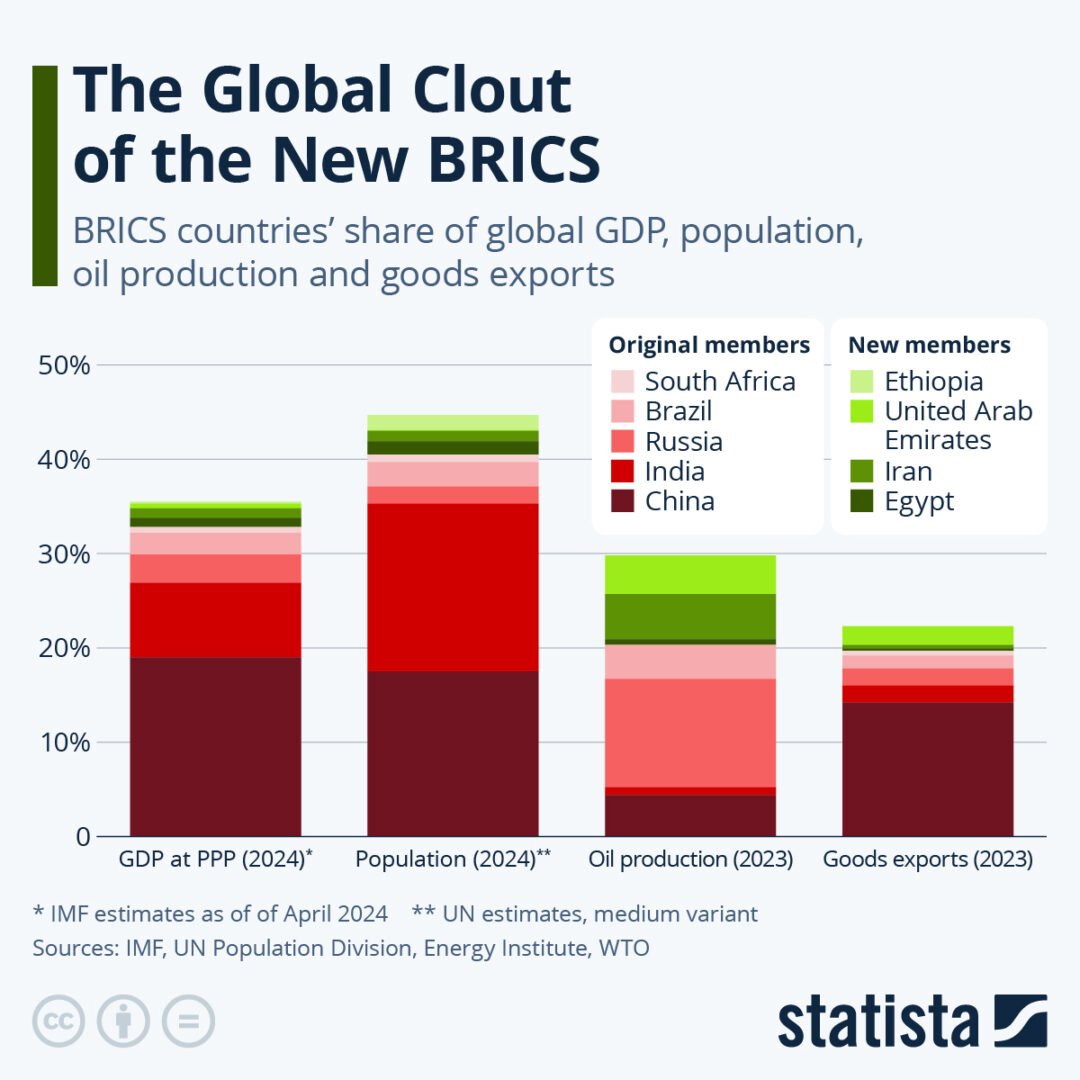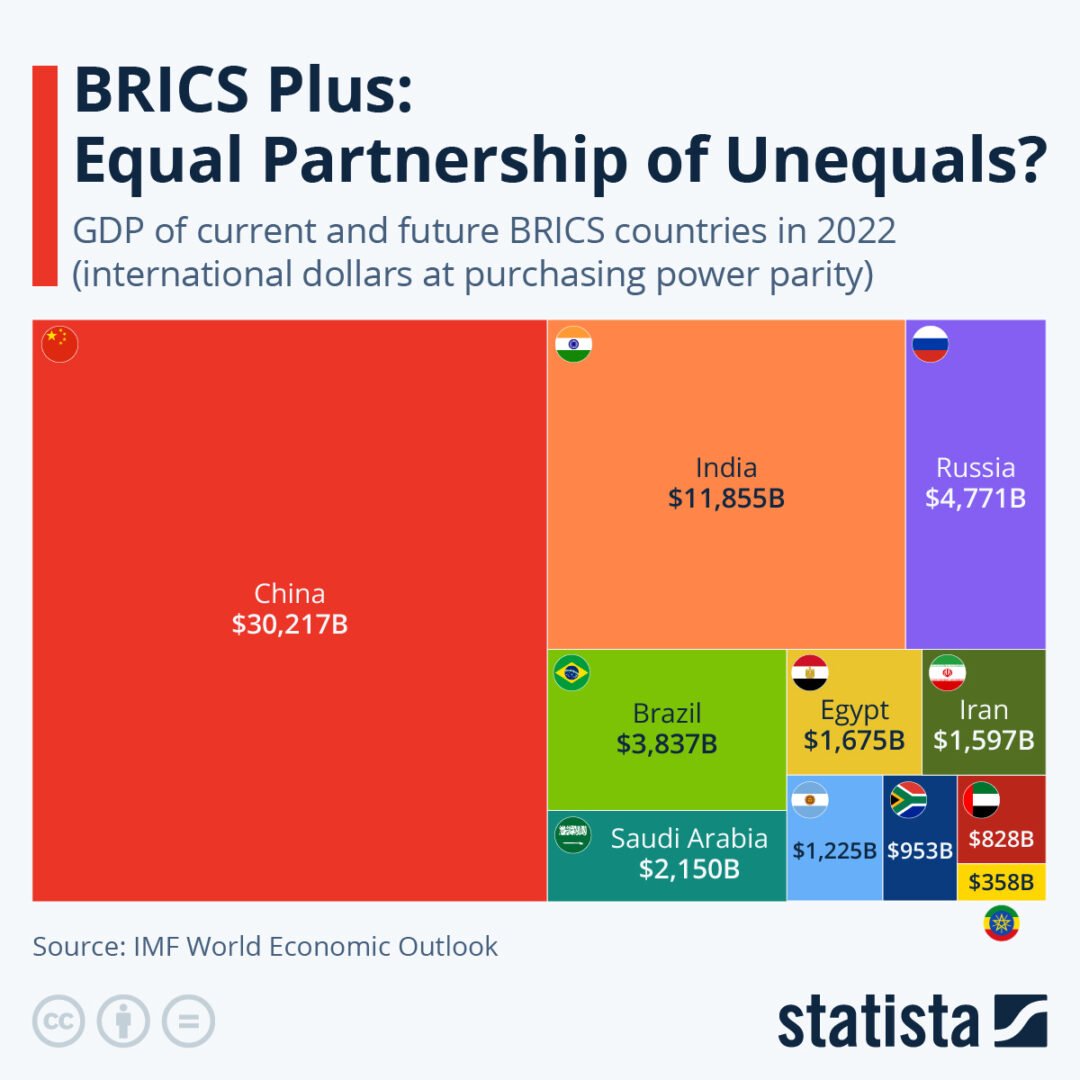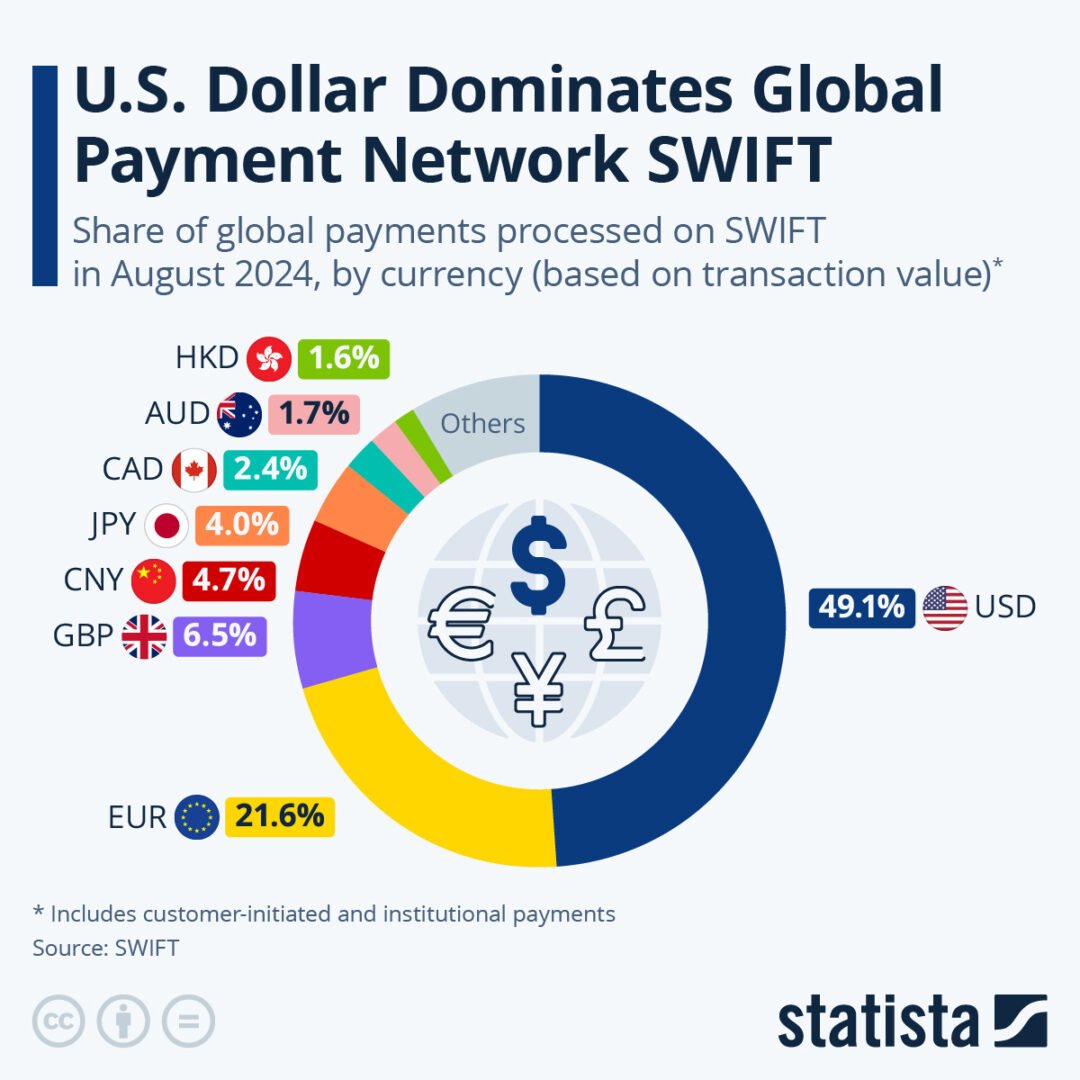Introduction
BRICS is a multilateral economic alliance promoting collaboration in trade, security, and development. It is a group of five emerging economies in the Global South, including Brazil, Russia, India, China, and South Africa. Furthermore, Egypt, Ethiopia, Iran, Saudi Arabia, and the United Arab Emirates (UAE) joined the group in 2023, creating BRICS Plus. The members of BRICS stand out for their rapidly growing economies, large populations, and increasing influence in global affairs.
BRICS has played an important role in reshaping global dynamics by promising a multipolar world order and giving a strong voice to the Global South. It poses a challenge to Western-dominated international institutions such as the International Monetary Fund (IMF) and the World Bank with its calls for a new and reformed international order. These countries call for reforms in the contemporary global financial and political institutions that reflect the realities of the 21st century.
Origin and Historical Background
In 2002, Jim O’Neill, an economist at Goldman Sachs, coined the term BRIC in his report “Building Better Global Economic BRICS” referring to the fast-growing non-western economies of Brazil, Russia, India, and China. He predicted that these countries would outpace the economic growth of the G7 and challenge the economic dominance of the Western economies in the future.

BRIC was formed in 2006. South Africa joined the partner countries in 2011, changing its formal name to BRICS. The group’s first summit was held in June 2009 at Yekaterinburg, Russia. Various factors acted as catalysts for the formation of BRICS. Firstly, the global financial crisis of 2008 shook the foundations of the US-dominated global financial system and gave impetus to efforts to build alternative economic systems.
Furthermore, the expulsion of Russia from the G8 in 2014 also strengthened the coalition as Russia sought to counterbalance the West by fostering new economic alliances. In addition, China and Russia, as strong proponents of a multipolar world, perceive BRICS as an opportunity to challenge the dominance of the Western economic system.
Evolution and 2024 BRICS Expansion
The expansion of BRICS can be divided into three phases. During the initial phase, the four founding members agreed to form BRIC. South Africa came along in 2011 marking the second phase of enlargement. The recent expansion came during the 15th BRICS Summit in Johannesburg with the inclusion of five more countries (Egypt, Ethiopia, Iran, Saudi Arabia, and the UAE). These countries, except Saudi Arabia, formally joined the alliance in January 2024. BRICS has opened its doors to include more countries in the future, including Turkey and Pakistan.
Significance of BRICS
Owing to its vast human, financial, and natural resources, BRICS economies are poised to be an important bloc in shaping the future international order. First, it represents around 3.5 billion, or 45% of the global population. Second, BRICS contributes around 28% to the total global GDP, which translates into $28.5 trillion. BRICS Plus produces 44% of the world’s crude oil.
In terms of economic clout, BRICS is the largest economic bloc, and it has even surpassed the G7, its main competitor. According to Statista, BRICS collectively hold 35% of the world’s GDP, compared to 29% by the G7.

Moreover, BRICS members also carry immense political clout in international organizations. For instance, recent data indicates that the group holds a 14% voting quota at the World Bank and a 15% voting share in the IMF. Lastly, four BRICS members, including China, India, Brazil, and Russia, are the largest food producers in the world, covering around half of the global food supply.
Working Principles
Although its official headquarters is in Shanghai, BRICS does not have a formal secretariat or a charter. Nevertheless, it holds regular annual summits of its heads of state where key decisions are deliberated and decided through consensus. However, the group has not yet adopted a formal character in the absence of a charter, secretariat, or common funds.
Each member country chairs the group for one year and hosts its annual summit. The current chair of the BRICS is Russia where the 16th BRICS Summit is currently underway. This is the first summit of the BRICS Plus with the participation of newly inducted economies such as Iran and Egypt.
Objectives of BRICS
The objectives of BRICS can be summarized as follows:
- Economic cooperation and development
- Multilateral cooperation
- Global governance reforms
- Solidarity among members
- South-South cooperation
- A new global economic order
- Alternative financial systems
Achievements by BRICS
Since its inception in 2006, BRICS has achieved several milestones benefiting the member states and the countries in the Global South.
Challenge to Western Financial Hegemony
To begin with, the ascendency of BRICS has successfully challenged the longstanding financial hegemony of the West. Members have resorted to alternative financial and commercial transaction mechanisms. A trend to trade in national currencies has gained traction among the members helping countries such as Russia to circumvent Western sanctions. For instance, China has established currency swap lines with several member nations promoting trade in yuan.

Collective Voice of Global South
Secondly, BRICS has provided a platform for countries in the Global South to raise their voices and grievances collectively. By effectively representing the collective interest of the developing world, it has succeeded in filling the void left by the failure of the Non-Aligned Movement (NAM) and G77. For instance, many BRICS countries have acted with unanimity on global challenges including the Iran nuclear program and conflicts in Afghanistan, Gaza, Libya, and Syria.
Financial Assistance to Developing Countries
Thirdly, BRICS has set up financial institutions to finance infrastructure projects and cushioned the balance of payment crisis to developing countries. For instance, the New Development Bank (NDB) and Contingent Reserve Arrangement (CRA) have a financial reserve of more than 100 billion dollars for funding projects Since 2016, NDB has disbursed nearly 32 billion dollars to emerging nations to construct new roads, and bridges, railways, and water supply projects.
BRICS Currency Replacing the Dollar
Fourthly, reducing the dependence on dollars for international trade and transactions has been on the BRICS agenda for decades. It has received acceptance from most of the members indicating their openness to conduct financial and economic transactions in their national currencies instead of relying on the dollar. Most members agreed on the need to create a new common digital currency or a BRICS currency during their 15th Summit in South Africa in 2023.
Global Institutional Reforms
Moreover, BRICS has put forth a unanimous agenda to reform global institutions. Many BRICS members deemed the veto power enjoyed by the P5 in the United Nations Security Council as inherently unjust and a relic of the past that does not align with contemporary realities. As Fareed Zakaria mentioned in his book, Post American World and the Rise of the Rest, the Global South is speedily catching up with the West leading to tectonic shifts in the international order. Therefore, under the auspices of BRICS demands for global institutional reforms are getting traction.
Enhanced Foreign Direct Investment
One of the most prominent achievements of the BRICS nations has been the steep rise in foreign direct investment within the bloc. For instance, the bloc’s annual foreign direct investment (FDI) inflows more than quadrupled from 2001 to 2021. In addition, member states are supportive of a more open investment policy environment.
Enhanced Contact among Leaders
In addition, BRICS leaders have retained close contact and engagement through regular annual summits of their heads to discuss issues at a multilateral forum. It has helped to forge close ties and friendships among its leaders. For instance, Russian President Vladimir Putin said to Indian Prime Minister Narendra Modi, during a bilateral meeting on the sidelines of the 16th BRICS Summit, “Our ties are so close, you wouldn’t need translation.” In addition, BRICS also provides a parliamentary forum for the engagement of ministers among its members.
Addition of New Members in 2024
The group holds immense political and economic clout due to membership from a wide range of countries from different regions. The addition of new members to BRICS has strengthened its geopolitical, geostrategic, geo-economic clout and material strength. The expansion of BRICS has been lauded by many experts as one of its huge achievements.
Strong Commitment to Environmental Sustainability
Moreover, showing a strong commitment to environmental viability, BRIC’s financial assistance has given special attention to environmental concerns such as clean energy, transportation, and sanitation. In this regard, BRICS has announced devoting 40 percent of its projects to tackling climate change.
Annual BRICS Games
BRICS games are annual sports events attended by hundreds of athletes and dozens of countries including BRICS members and other countries primarily from the developing world. For instance, this year the global event was held in Russia which was attended by around 80 countries fostering cultural ties and people-to-people contact.
Regional Connectivity
BRICS countries also agreed to build an undersea cable network to connect members. The project is likely to cost around 1.5 billion dollars.
Challenges Faced by BRICS
Several challenges are knocking at the doorstep of BRICS nations which need to resolve for achieving its objectives.
Multi-alignments and Conflict of Interests
To begin with, BRICS members such as India are part of the Western alliances such as the QUAD and Indo-Pacific Strategy designed to contain China and Russia, which could potentially lead to disharmony and distrust within the bloc. This approach adopted by India could lead to a conflict of interests and undermine unity within the alliance.
Divisions within the Bloc
There is a lack of consensus about common currency as members are deeply embedded in the SWIFT financial system which revolves around the US dollar. For example, India has pushed back against de-dollarization as it has forged close strategic and economic ties with the West. Furthermore, the enlargement of the group into BRICS Plus is more likely to create challenges for building consensus among members due to the diversified interests of its members.

Pushback from the Western Countries
The West considers the BRICS an alliance headed by Russia and China to reshape the existing liberal order by projecting an illiberal order that directly contradicts the West. For instance, the US-led West has always perceived the group as a rival to the G7 group. Therefore, it is more likely to be contained by the West.
Small Footprint of BRICS Financial Institutions
These BRICS institutions have a minuscule footprint in the global financial market compared to the Bretton Woods-institutions-World Bank and IMF. For instance, the NDB is more than five times smaller than the World Bank. It has also faced criticism for vague commitments on environmental and social impact standards.
Sanctions on BRICS member states
BRICS members are also faced with the daunting challenges of financial and economic sanctions by the West. It is a major obstacle in undertaking free trade among its members which are isolated from the global financial market. These sanctions have the potential to produce crippling impacts on these countries.
Significance of BRICS for Pakistan
Pakistan is currently an observer state of BRICS Plus. It applied for full membership in 2023, however, India blocked Pakistan’s membership due to its political motives. It cited the economic instability of Pakistan as the primary reason for its decision. However, after support from Russia, Pakistan is more likely to grab a seat in the BRICS Plus soon.
Pakistan has applied for membership based on the principle of inclusive multilateralism. BRICS membership could bring immense economic opportunities for the country due to its geographic location and the forging of economic ties with fast-growing economies. Nonetheless, membership in BRICS is not devoid of its challenges.
Dividends for Pakistan
Joining BRICS as a permanent member could unlock several dividends for Pakistan and the region.
- Multilateral Engagements and Diversification
Firstly, the expanded BRICS provides a unique opportunity for Pakistan to diversify its economic relations with emerging economies in the Global South such as Brazil and South Africa. In addition, Pakistan could also cement its economic ties with resource countries of the Middle East using the BRICS forum by tapping avenues of trade, investment, and cooperation.
- Economic Opportunities
Secondly, Pakistan is poised to gain numerous economic and financial dividends by accessing new markets, boosting trade, and tapping investment opportunities. By adopting a multilateral approach, Pakistan could attract investment, gain technology, and access credit loans from BRICS countries situated in different regions.
- Fostering its Geo-economic Position
Thirdly, Pakistan’s unique geostrategic location and long coastline (around 1,100 km) can be a boon for BRICS members to raise their potential in maritime trade by accessing the Indian Ocean. Being a key player in the Belt and Road Initiative (BRI) and China-Pakistan Economic Corridor (CPEC), more countries from BRICS can join the economic project to enhance regional connectivity and trade
- Financial Support
Access to the New Development Bank (NDB) could provide funding for infrastructure projects and reduce its heavy reliance on Western financial institutions. Being one of the most indebted countries to the IMF, Pakistan could look for alternative funding sources for development.
- Political Influence
Through BRICS, Pakistan has a global platform to voice its demands for global institutional reforms based on democratic principles. For instance, enlarging the UNSC has been a longstanding demand of Pakistan and BRICS gives a unique platform.
Obstacles for Pakistan to Join BRICS
- Opposition from India
The most formidable stumbling block in Pakistan’s road to joining BRICS Plus is opposition from India. For instance, India blocked Pakistan’s invitation to the “High-level Dialogue on Global Development” in 2022 on the sidelines of the BRICS Summit.
- Internal Economic Turmoil
Another major challenge for Pakistan to join BRICS remains the fragile economic condition at home. BRICS is a group of emerging and fast-growing economies where Pakistan will hardly find a favorable place until it fixes its economy and moves toward long-term stability.
- Western Political Pressure
WestOther BRICS Plus excluding India could also derail Pakistan’s efforts to join the alliance due to the group’s anti-Western posture. Alongside Pakistan’s membership in China-led SCO, western countries would undermine any efforts by Pakistan to join another bloc that is deemed anti-West.
Conclusion
To put it in a nutshell, Pakistan needs to make its case stronger by branding its geographic location which would strengthen land and sea connections among BRICS member countries. It needs to reach bilaterally other developing countries within the BRICS and BRICS Plus members to diversify its economic relations. For Pakistan to become an indispensable potential member of the BRICS, it must put its own house in order by enacting long-term structural economic reforms focused on steady investment inflows and exports.
Simultaneously, Pakistan should actively enhance its diplomatic relations with current BRICS members through bilateral discussions, engagement in BRICS-related forums, and diplomatic exchanges aimed at deepening ties and aligning mutual interests.
He writes on a diverse range of topics such as geopolitics, economy, social inequality, governance, and other important current affairs stories in national and international spheres.



